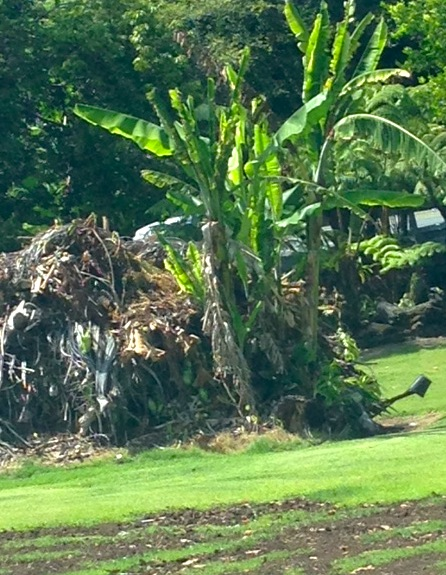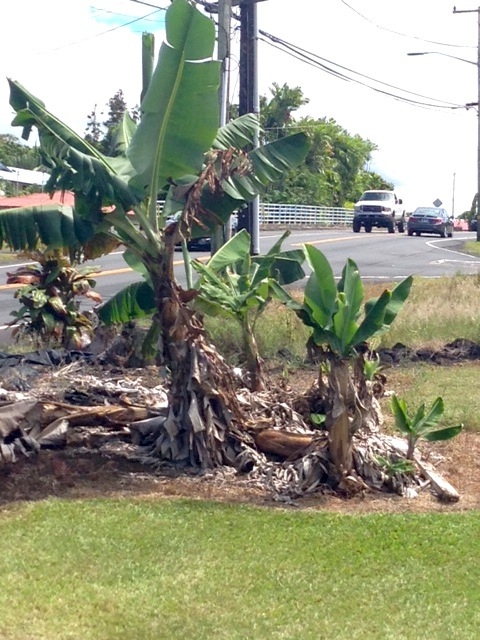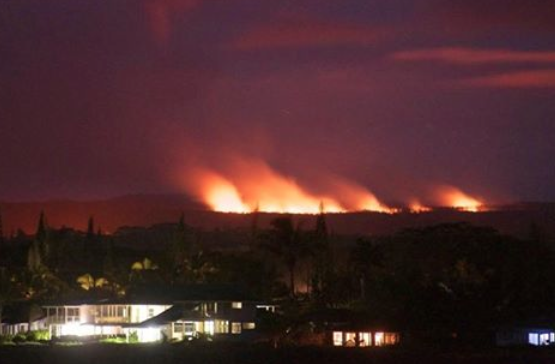Richard Ha writes:
Back in the ‘80s, there was a fire in Maku‘u between Hawaiian Paradise Park and Hawaiian Beaches. It burned all the way down to the ocean.
I used to do a lot of dirt bike riding back then with my brother-in-law Dennis Vierra and Wayne Blyth. When the fire was out, they made some roads around the perimeter, and any excuse to ride the bikes, right? We went exploring.
We went in by an old hunter’s trail that started near the Maku’u farmers market, and we saw something really strange. There were all these really tall trees that weren’t burned. They were green, and really tall. They were growing through a hole in the lava, and it turned out it was the entrance to a lava tube—the top had collapsed and the trees had grown on top of it. It collapsed a long time ago, because those trees were huge.
We went to explore and we found an entrance into that lava tube that was set up with rocks and nice stone work. Somebody had gone to a lot of trouble to fix it really nicely so you could walk into it, but not too many people at once. Maybe so people couldn’t attack it. Or in case someone was guarding the entrance?We thought it was neat and decided to go back again the next week when we would bring flashlights.
So we went back a week later with our mountain bikes and brought gloves and flashlights and we went into the cave, and it was pretty interesting. The first thing we saw were enormous ‘opihi shells. I’ve never in my life seen ‘opihi shells that size come out of the ocean there in Puna. They were bigger around than a coffee cup. Maybe half again bigger. There were quite a lot of them. And we saw charcoal, so it looked like people had made fires there.
We started walking. The cave was maybe ten or fifteen feet high in places. The top had collapsed over time and there was a pile of rubble maybe three or four feet high in the middle, so you had to walk on either side of it.
It wasn’t perfectly round, but it got narrow on the left and right edges and looked like there were shelves, like you could set things there, or maybe hide bodies there, but none of us said that out loud. And we didn’t dare go look.
We kept walking, maybe about a mile and then we came to what looked like a dry waterfall. The shape of the lava went uphill and we could feel fresh air at the top, so we climbed up and kept going.
Toward the end, we found more rock work. At that end, only one person at a time could pass through the narrow opening someone had created rocks. It led to an opening at the top so we could leave the lava tube, and we came out in the forest.
We had absolutely no idea where we were. No idea at all. It was still light out but we had no way to find civilization.
It was pitch dark in the lava tube, but we knew that was the only way we could find our way back, so we went back in. We went back the way we’d come and we started going faster and faster, because it was kind of spooky in there.
About halfway through we realized we could see some diffused light coming from the ceiling. There was a hole in the ceiling where the lava was very thin.
And what occurred to me was that if anyone was walking in the forest above and fell through into the lava tube, they would have absolutely no way of finding their way out. Without a flashlight, it’s pitch dark and you absolutely wouldn’t be able to find your way out at all. That would just be it. It was a scary thought.
I don’t know if it’s a place where people used to hide. Or was it a burial cave? How many hundreds of years ago was that? I couldn’t see any evidence of people having lived in that area – no taro lo‘i or anything. There were no trails there. Who built that stone work? Who did all that work? It was very organized. Was it to protect themselves? Did they have people out there at the entrances?
We only went into it that one time, and it’s still out there somewhere, between Pahoa and Ainaloa on the transfer station side of the highway, and I’m sure there are many others, too. I hadn’t thought about that in many years, but now with all the lava moving through the area and going down into cracks and everything, it came to mind. It was an interesting experience.
From Big Island Video News:
PUNA, Hawaii – Lava is a mere three tenths of a mile from entering Kaohe Homesteads, reports Hawaii County Civil Defense. An evacuation has not yet been ordered for residents of Kaohe but that could change at any time. Civil Defense personnel will be conducting door to door surveys and notification in the subdivision starting today.
Read the rest






